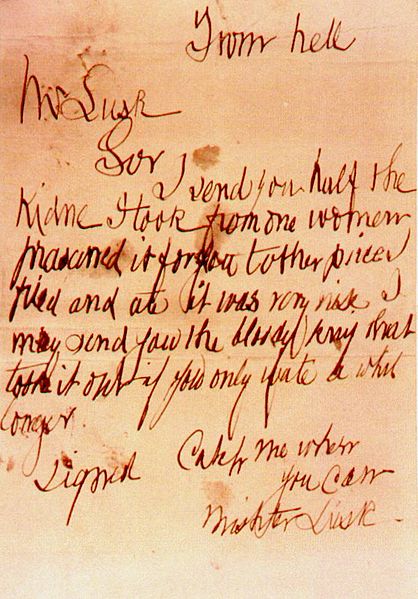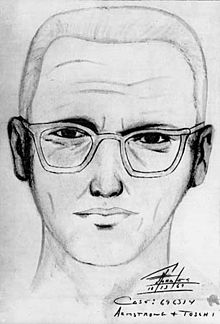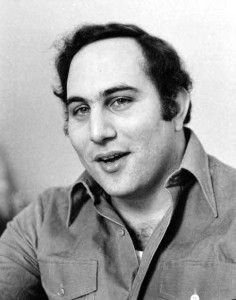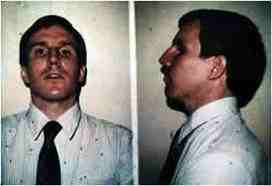
Jack the Ripper's "From Hell" Letter
From Jack the Ripper through B.T.K. in Wichita, Kansas, certain serial killers crave media attention to chronicle their infamous deeds.
by Ben Johnson
The relationship between serial killers and the media is one that has spanned centuries and divided opinion.
From the panic-inciting Penny Dreadfuls published in the fog-filled squalor of Victorian London slums, to the online, on demand, news consumed in the high-tech offices of today, there can be no doubt about one thing: Serial killers sell newspapers, and nobody exploits this fact more than a killer with a desire to be acknowledged.
Some killers are merely happy to collect the cuttings telling of their foul deeds, clipped from the pages of lurid tabloid newspapers. Some use these stories to relive their terrible crimes and some take things a step further. They write their own news.
These infamous few are unique in the world of crime, taunting police with their boastful claims, causing panic amidst communities around the world, and puzzling the minds of right thinking members of society with their cryptic clues and ciphers.
Whether we like it or not, these killers become celebrities. Dark-hearted stars who cause revulsion and fascination in equal measure.
Jack the Ripper
 |
| Jack The Ripper |
Throughout the last 150 years, there have been a number of media-reliant serial killers. The first of whom is still renowned as the forerunner of all modern serial killers: The infamous Jack the Ripper.
Without doubt, the Jack the Ripper murders are still one of the world’s great unsolved mysteries. Believed to have been responsible for the murders of between four and eight prostitutes in the East End slums of Victorian London, Jack the Ripper was worldwide news in its own time, and remains an enigma today.
But, aside from the sheer brutality of his crimes, one of the most prominent factors in the infamy of this case is the fact that the already hysterical public were exposed directly to the words of this killer by a series of letters received by investigators and press.
The most infamous of these letters is known as the “Dear Boss” letter, which was received by the Central News Agency of London on September 27, 1888.
Many dedicated Ripperologists would argue that the letters were the work of a fraud. Police investigators attempting to draw out the killer and journalists in an effort to sell their stories have often been accused of creating the Ripper letters.
However, these taunting and self-congratulatory notes contain details of the crimes which strongly indicate knowledge of the murders, and also hint at future events, all of which were to happen.
The “Dear Boss” letter (printed below) is the most graphic and knowledgeable of the Rippers writings, and is still the source of debate and conspiracy theory today.
Dear Boss,
I keep on hearing the police have caught me but they won’t fix me just yet. I have laughed when they look so clever and talk about being on the right track. That joke about leather apron gave me real fits. I am down on whores and I shan’t quit ripping them till I do get buckled. Grand work the last job was. I gave the lady no time to squeal. How can they catch me now. I love my work and want to start again. You will soon hear of me with my funny little games. I saved some of the proper red stuff in a ginger beer bottle over the last job to write with but it went thick like glue and I can’t use it. Red ink is fit enough I hope ha ha. The next job I do I shall clip the lady’s ears off and send to the police officers just for jolly wouldn’t you. Keep this letter back till I do a bit more work, then give it out straight. My knife's so nice and sharp I want to get to work right away if I get chance.
Good Luck
Yours Truly
Jack the Ripper.
Don't mind me giving the trade name.
PS Wasn’t good enough to post this before I got all the red ink off my hands curse it. No luck yet. They say I'm a doctor now ha ha.”
This letter also sets a benchmark in the relationship between serial killers and the press in that it allowed the killer to give himself a name. The killer was simply known as the “Whitechapel Murderer” before the publication of this letter, but the press soon latched onto the macabre signature and began to use the name in their lurid headlines.
This public self-baptism is something that will be encountered during several criminal investigations over the next century and beyond.
The Axeman of New Orleans
 Thirty years later, and almost 5,000 miles away, a series of murders took place which would mirror the Ripper murders in many ways. Public hysteria, a letter to the press, and a killer who was never caught make this another puzzle in the annals of the history of crime.
Thirty years later, and almost 5,000 miles away, a series of murders took place which would mirror the Ripper murders in many ways. Public hysteria, a letter to the press, and a killer who was never caught make this another puzzle in the annals of the history of crime.
New Orleans, Louisiana has always been looked upon as a melting pot of cultures and lifestyles. An easy-going place with a relaxed lifestyle. The Big Easy.
Yet, almost a century ago, the city was in the grip of a series of brutal murders which brought with them a sense of fear and panic, the likes of which had never been experienced by its inhabitants.
The murders themselves were more terrifying than those of Jack the Ripper, as the victims in this case were attacked in their own homes and bludgeoned to death with an axe.
The killer, referred to by the press as the Axeman of New Orleans, kept to a very strict modus operandi. He would enter the homes of his victims by chiselling a panel out of the door, and would approach his victims as they slept. An axe was also left behind at every crime scene, a chilling memento of a visit by the Axeman.
His victims were usually grocers of Italian descent and their families, the reason for this has still never been fathomed despite a century of both professional and amateur investigation.
Officially, the Axeman claimed eight lives, and seriously injured several more, but it is widely believed that the actual body count is much higher. As with many historical serial murder cases, the police were still largely made up of amateur volunteers, and comparing notes with their counterparts in neighbouring areas was almost unheard of.
For two years the city was gripped by the murderous reign of the killer. Vigilante groups patrolled the streets and families huddled together by candlelight to sleep in fear of the Axeman.
The elusive killer quietly went about his work until March 1919, and then the floodgates of panic were once again opened. A letter claiming to be from the killer to the New Orleans Times-Picayune was published.
Hell, March 13, 1919.
Esteemed Mortal:
They have never caught me and they never will. They have never seen me, for I am invisible, even as the ether that surrounds your earth. I am not a human being, but a spirit and a demon from the hottest hell. I am what you Orleanians and your foolish police call the Axeman.
When I see fit, I shall come and claim other victims. I alone know whom they shall be. I shall leave no clue except my bloody axe, besmeared with blood and brains of he whom I have sent below to keep me company.
If you wish you may tell the police to be careful not to rile me. Of course, I am a reasonable spirit. I take no offense at the way they have conducted their investigations in the past. In fact, they have been so utterly stupid as to not only amuse me, but His Satanic Majesty, Francis Josef, etc. But tell them to beware. Let them not try to discover what I am, for it were better that they were never born than to incur the wrath of the Axeman. I don‘t think there is any need of such a warning, for I feel sure the police will always dodge me, as they have in the past. They are wise and know how to keep away from all harm.
Undoubtedly, you Orleanians think of me as a most horrible murderer, which I am, but I could be much worse if I wanted to. If I wished, I could pay a visit to your city every night. At will I could slay thousands of your best citizens, for I am in close relationship with the Angel of Death.
Now, to be exact, at 12:15 (earthly time) on next Tuesday night, I am going to pass over New Orleans. In my infinite mercy, I am going to make a little proposition to you people. Here it is:
I am very fond of jazz music, and I swear by all the devils in the nether regions that every person shall be spared in whose home a jazz band is in full swing at the time I have just mentioned. If everyone has a jazz band going, well, then, so much the better for you people. One thing is certain and that is that some of your people who do not jazz it on Tuesday night (if there be any) will get the axe.
Well, as I am cold and crave the warmth of my native Tartarus, and it is about time I leave your earthly home, I will cease my discourse. Hoping that thou wilt publish this, that it may go well with thee, I have been, am and will be the worst spirit that ever existed either in fact or realm of fancy.
The Axeman.
The letter terrified the people of New Orleans. The killer was claiming to be a disciple of the devil. With the threat of more murders and the knowledge that nobody was safe, the “Orelanians” did the only thing they could. They threw a huge party.
The killer had threatened to take another victim the following Tuesday from a place where he was unable to hear jazz music playing. Therefore, on the night in question, every music hall was full to the rafters and the sounds of jazz floated through the streets.
Nobody was killed by the Axeman that night, or the following night. In fact, the killings had ceased altogether.
Although less well known than the Jack the Ripper case, this series of murders has become legendary for conspiracy theorists and amateur sleuths around the world. Yet, without the letter to the Times-Picayune, the case would have simply been a series of unsolved murders.
The publication of the letter and its subsequent effect on an entire city are the main factors behind the legend of the Axeman of New Orleans.
Due to their historical nature, the Jack the Ripper and Axeman of New Orleans cases have become legendary tales of intrigue and conspiracy, it is simply due to the passage of time that when studying these cases, very few people feel revulsion towards the killer, or empathy towards the victims. This is another of the effects of media saturation on a serial murder case. The simple details get lost in the mix. The victims themselves become trivial statistics, whilst the killer becomes legendary, or at worst, infamous.
Also, the fact that these killers were never caught also adds to our sense of intrigue. But do we also view more recent unknown killers with the same gravitas? Fifty years after the Axeman disappeared into the annals of history, another killer would become the subject of thousands of column inches, many written by his own hand.
Zodiac
 |
| Zodiac Killer Composite |
The people of northern California, including the police and media, were held ransom by this killer who demanded that his crimes be recognized. Never caught, he was known only as Zodiac.
Perhaps the most prolific user of the media in all serial killer cases, Zodiac communicated through several local newspapers, although he most often used the San Francisco Chronicle as his literary outlet. His letters were taunting and disturbing, often threatening more killings if his wishes were not adhered to, but perhaps more unsettling were the ciphers which he had so patiently created to test his readers.
The first letter received by the Chronicle was accompanied by part of a cipher. Identical letters had also been received by the Vallejo Times Herald, and the San Francisco Examiner. The Chronicle chose to print the letter, in which the killer took credit for a recent double murder at a local lover’s lane, and their respective portions of the cipher.
However, in an effort to show the killer that the media was not to be blackmailed, the letter was printed on the fourth page of the next day’s issue, as opposed to the front page, which the killer, in his letter, had demanded in order to cease from a planned murder in the near future.
The gamble appeared to pay off, as no killings were reported in the immediate aftermath of the publication. The newspaper however, asked that the killer send them a second letter to prove that he was the Zodiac, and to include details of the murders which would be unknown to anyone but the killer. The first letter is printed below.
Dear Editor
This is the murderer of the 2 teenagers last Christmas at Lake Herman + the girl on the 4th of July near the golf course in Vallejo To prove I killed them I shall state some facts which only I + the police know.
Christmas
- Brand name of ammo: Super X
- 10 shots were fired
- the boy was on his back with his feet to the car
- the girl was on her right side feet to the west
4th July:
- girl was wearing patterned slacks
- The boy was also shot in the knee.
- Brand name of ammo was western
Here is part of a cipher the other 2 parts of this cipher are being mailed to the editors of the Vallejo Times + SF Examiner.
I want you to print this cipher on the front page of your paper. In this cipher is my identity.
If you do not print this cipher by the afternoon of Fry.1st of Aug 69, I will go on a kill ram-Page Fry. night. I will cruise around all weekend killing lone people in the night then move on to kill again, until I end up with a dozen people over the weekend.”
This particular request proved controversial, as many people believed that the Zodiac was spurred on by the media attention. Even today, whether a newspaper should print a letter by a killer is a subject which will divide opinion. Many would argue that without a chance of fame and notoriety, an attention-seeking killer would simply have no reason to kill. Others would claim that any such correspondence would be in the public interest, therefore, the newspaper has a duty to publish it, whatever the consequences.
The killer also used the opportunity to give himself a name, like the aforementioned killers, referring to himself as “Zodiac” in his second letter. The killer also signed the letter with a symbol which resembled a crosshair. He would later demand that this symbol appear on buttons worn by everybody in San Francisco.
Like Jack the Ripper and the Axeman of New Orleans, Zodiac seems to fall into a particular category of media manipulating killer: The attention seeker.
Other killers will communicate with the press as a means to highlight their political or religious beliefs, and some, either consciously or subconsciously, just want to be caught. The attention seeker is perhaps the most dangerous of all, as he will kill for attention, and then keep killing to maintain that attention, often stepping up his attacks when the limelight begins to fade.
Zodiac would go on killing for a year, eventually claiming five official victims, with two others seriously injured, however, the letters following each murder hinted at a much higher number.
Oddly, the letters and ciphers continued long after the last of the murders. With the killer eventually sending up to 20 letters, ciphers and greetings cards to the local media.
While Jack the Ripper remains the most famous serial killer of all time, it can certainly be said that when studying killers in terms of manipulation and a thirst for fame, Zodiac would the first name on the list.
Whether there are any links between the fact that the three killers examined so far were never caught, and their insatiable appetite for recognition is open to debate, but the next killer would be caught, and would give the world of criminal investigation an insight into the mind of a media manipulating serial killer.
Son of Sam
 |
| David Berkowitz |
The man who invented the term “serial killer,” ex-FBI agent and criminal profiler Robert K Ressler, once said of our next subject “The power that he held over the city, and over the sale of newspapers, was stupendous, and very exciting for him. Having read about the idea of communicating with the police from a book on Jack the Ripper, he slipped a note into the seat of the car in which his first victim lay dying, a note in crude letters that read, 'Bang Bang...I'll be back.'”
David Berkowitz, self-dubbed as the “Son of Sam” (among many other nicknames he suggested for himself) was much less prolific in his correspondence than Zodiac, but his control over an entire city was largely due to his control over the media.
Killing six people and wounding several others, Berkowitz concocted an incredible tale of demonic possession in order to fool the jury into finding him insane.
Despite a number of taunting letters sent to police, the most interesting correspondence came in a letter sent to Jimmy Brisling, a daily columnist with the New York Daily News. The letter is fascinating as it hints at desperation to become known for his “work,” even going as far as to take on a boastful tone, and suggest possible nicknames for himself.
If ever there was an example of a serial killer wanting to be recognized for his work, this is it.
Hello from the cracks in the sidewalks of NYC and from the ants that dwell in these cracks and feed in the dried blood of the dead that has settled into the cracks.
Hello from the gutters of NYC, which is filled with dog manure, vomit, stale wine, urine, and blood.
Hello from the sewers of NYC which swallow up these delicacies when they are washed away by the sweeper trucks.
Don't think because you haven't heard for a while that I went to sleep. No, rather, I am still here. Like a spirit roaming the night. Thirsty, hungry, seldom stopping to rest; anxious to please Sam.
Sam's a thirsty lad. He won't let me stop killing until he gets his fill of blood. Tell me, Jim, what will you have for July 29? You can forget about me if you like because I don't care for publicity.
However, you must not forget Donna Lauria and you cannot let the people forget her either. She was a very sweet girl.
Not knowing what the future holds, I shall say farewell and I will see you at the next job? Or should I say you will see my handiwork at the next job? Remember Ms. Lauria. Thank you.
In their blood and from the gutter - 'Sam's creation' .44."
The Daily News decided to omit part of the letter, in order to regain some sense of control. The part of the letter which was omitted was where Berkowitz gave a list of possible nicknames for himself. This could have been an attempt to assert power over the killer by denying him the chance to publicise himself, or simply that the Daily News had already settled on the Son of Sam.
The unpublished section reads “Here are some names to help you along. Forward them to the Inspector for use by the NCIC Center. They have everything on computer, everything. They just might turn up, from some other crimes. Maybe they could make associations.
Duke of Death. Wicked King Wicker. The 22 Disciples of Hell. And lastly, John Wheaties, rapist and suffocator of young girls. P.S., drive on, think positive, get off your butts, knock on coffins, etc.”
The nature of most letters received by the press in these kind of cases is mostly one of self promotion and assertion of power, this seems to be a universal trait in attention-seeking serial killers.
The Red Spider
 |
| Lucian Staniak |
Although most well known cases are from the west, the former Eastern Bloc has had its share of serial murder over the years, but information was often hard to come by due to the Iron Curtain and the paranoia and secrecy that went with it.
A case from communist-era Poland certainly matches its western counterparts in regards to the media being manipulated by a killer.
, the “Red Spider” weaved a web of murder and poetic intrigue across an entire nation during the 1960s. His frequent letters to newspapers were scrawled in red ink, and the style of his handwriting gave him the nickname which would heighten the sense of terror at the mention of his name.
Convicted of six murders, Staniak later confessed to 20, although it is widely believed that his confession was coerced by police intent on clearing up their unsolved murder cases.
His victims were exclusively young blonde women who were killed extremely violently. His methods were unusual as they didn't follow any particular modus operandi; they included strangulation, stabbing and beating his victims to death.
Staniak's letters to the press were also unusual, as they usually preceded his attacks, warning of murders to come.
His first letter was to Warsaw based newspaper Prezeglad Polityczny in which the poetic killer threatened “There is no happiness without tears, no life without death. Beware. I am going to make you cry.”
He also claimed that he would kill in Warsaw, but this was a bluff to give himself time and space to commit his murder. The killing was actually carried out in Olsztyn.
In his second letter, this time to another Warsaw based newspaper, Kulisy, he boasted “I picked a pretty flower in Olsztyn and I shall do it again somewhere else, for there is no holiday without a funeral.”
Both letters were handwritten in red ink, which was later found to be red artists paint thinned with turpentine. This would later be a valuable clue as to the identity of the Red Spider.
His next murder was so gruesome that details were never released to the public, but police records show that his victim was stabbed over 200 times with a screwdriver after being chloroformed and raped and bundled into a packing case which was found several hours later.
The next day a Poznan newspaper received a letter quoting Stefan Zeromski's 1928 novel Populi.
“Only tears of sorrow can wash out the stain of shame, only pangs of suffering can blot out the fires of lust.”
The murders continued, with the killer confident that he would remain at large. He even killed a 17- year-old girl on a train, leaving a note stuffed between two seats which read “I have done it again.”
Staniak's reign of terror was, however, soon to come to an end, with police closing in after making a connection between the murder locations, and the rail journeys needed to commit them.
The killer, they deduced, would live in Krakow, which was the central point in an axis of murder. Police also decided that the only people who would have the means to make these journeys were government employees, who were given a special ticket which allowed them to make journeys around Poland.
The final piece of the jigsaw fell into place when it was realised that two of the victims were sisters, killed in separate attacks. Both of whom were members of an art class in Krakow.
Police found that a government employee was also a member of the art class. Lucian Staniak. They searched his locker and found a variety of knives. His latest work was also an insight into the mind of Staniak.
Entitled the “Circle of Life,” it depicted a cow eating a flower, a wolf eating the cow, the wolf being shot by a hunter, and the hunter being run down by a female motorist. The last panel showed a blonde woman lying spread-eagled with her abdomen slashed open. Flowers were sprouting from the wound.
As for Staniak, he wasn't there. He was in the process of committing his final murder in which he stabbed an 18-year-old student to death with a broken vodka bottle in a railway shelter. In his haste, he made his next mistake: He left a clear fingerprint on the neck of the bottle.
Immediately arrested, Staniak readily confessed to his crimes. He was sentenced to death, but later declared insane, being admitted to the Katowice Mental Hospital where he still resides today.
During his trial, Staniak's motives became clear. His family had been killed in a car crash involving the young, blonde wife of a Polish Air Force pilot. His victims were chosen for their resemblance to the woman who Staniak believed to have taken the lives of his family.
This case shows that serial murder exists across the globe, and writing to the press is not exclusively a trait in western killers. Staniak was unusual however, as his writing was poetic and sent to several different newspapers.
This would indicate that Staniak wasn't an attention-seeking killer; he was using the media as an outlet for both his creativity and rage. He wanted the world to see how badly life had treated him, and how he had succeeded in the face of adversity.
Staniak was the last person that anyone would suspect of being a killer, and so was the killer in the next case, for which we go back to the United States, but go forwards 20 years.
This time the killer was a married father with a respectable job and a position within his local church.
B.T.K.
 |
| Dennis Lynn Rader, "The BTK Killer" |
Dennis Rader, self-christened as B.T.K (Bind, Torture, Kill) remained at large for 30 years before his use of the media became his downfall.
Committing at least 10 murders in and around Wichita, Kansas, Rader promoted his own crimes in letters to local media outlets, most often the Wichita Eagle.
Unusually, this killer took a hiatus from his work and disappeared from the media spotlight between 1991 and 2004. His desire to return to the headlines was heralded by a new letter sent to the Eagle, some 13 years after his last correspondence.
However, by this time, the world of the media and communications in general had changed, and Rader was persuaded by the authorities to embrace technology.
His change from the lost art of letter writing to the modern use of computer-based communication was a step too far for this vicious killer.
Assured by police that he could not be traced by these electronic means, Rader left virtual fingerprints all over his next taunting note.
It is usually relatively easy to access the metadata of any electronic correspondence, and this case proved no different.
The information showed that the letter had been typed on a computer registered with the Wichita Lutheran Church, by a user named “Dennis.”
The police checked the information and cross-related it with their long list of suspects. The rest is history. Certainly so for Rader, who is currently serving 10 life sentences at El Dorado Correctional Facility, without chance of parole until 2180.
This case highlights an important issue in the relationship between serial killers and the press. While most would assume that media coverage would hinder a case, often, a killer is caught by his thirst for fame, and the media can be a vital weapon in the armoury of law enforcement.
The relationship between the media and the police in these cases can be awkward, with both trying their utmost to catch the culprit, and often clashing over methods and ethical considerations.
Sherry Chisenhall, editor of the Wichita Eagle freely admits to acting against the wishes of the police, in order to preserve the sanctity of ethical journalism.
“The police wanted several pieces of information withheld from the letter...the only piece that we agreed to withhold was a small symbol that BTK always drew on his letter...the public interest in being able to verify the authenticity of (Rader's) letters was convincing.”
The Happy Face Killer
|
|
| Keith Hunter Jesperson |
This clash between police and the press was also a feature in this final case, where a journalist defied the police, the district attorney and often his own instincts to free two wrongly convicted people after receiving a fateful letter adorned with a “happy face.”
Keith Hunter Jesperson, aka the “Happy Face Killer” is currently spending the rest of his life behind bars for the murders of eight women, but has, in the past, hinted at many more.
His job as a long-distance truck driver gave him the opportunity to kill, and the means to make an anonymous getaway
A prolific communicator (his first being a note scrawled on the bathroom wall of a truck stop), Jesperson revelled in writing letters to the police and local media. His most important was a six-page letter to journalist Phil Stanford of the Portland Oregonian.
It was this letter which was to prove instrumental in freeing two innocent people.
Stanford used information shared by Jesperson that gave details of the crimes which would only be known by the killer to eventually persuade the authorities that they had jailed the wrong people.
This campaign, however, was difficult and required persistence and a strong stomach for facing adversity. Traits which separate good journalists from the rest.
Stanford was kind enough to offer advice to any other journalist who finds themselves in a similar situation. “Maintain an open mind when considering the evidence. Evaluate carefully and don't jump to any conclusions.”
This subject is a fascinating one which has provided discussion for over a century, but it is important to remember that every case is different. Sometimes the relationship between a killer and the press is purely sensationalist, but often these headlines are created to warn the general public of a killer in their midst, and who can argue that this information is not in the public interest.
In all the above cases, the journalists acted ethically and professionally, despite producing news that shocks and reviles the reader.









